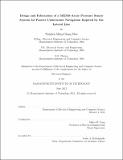Design and fabrication of a MEMS-array pressure sensor system for passive underwater navigation inspired by the lateral line
Author(s)
Hou, Stephen Ming-Chang, 1981-
DownloadFull printable version (9.091Mb)
Alternative title
MEMS-array pressure sensor system for passive underwater navigation inspired by the lateral line
Design and fabrication of a microelectromechanical systems-array pressure sensor system for passive underwater navigation inspired by the lateral line
Other Contributors
Massachusetts Institute of Technology. Dept. of Electrical Engineering and Computer Science.
Advisor
Jeffrey H. Lang.
Terms of use
Metadata
Show full item recordAbstract
An object within a fluid flow generates local pressure variations that are unique and characteristic to the object's shape and size. For example, a three-dimensional object or a wall-like obstacle obstructs flow and creates sharp pressure gradients nearby. Similarly, unsteady flow contains vortical patterns with associated unique pressure signatures. Detection of obstacles, as well as identification of unsteady flow features, is required for autonomous undersea vehicle (AUV) navigation. An array of passive underwater pressure sensors, with their ability to An object within a fluid flow generates local pressure variations that are unique and characteristic to the object's shape and size. For example, a three-dimensional object or a wall-like obstacle obstructs flow and creates sharp pressure gradients nearby. Similarly, unsteady flow contains vortical patterns with associated unique pressure signatures. Detection of obstacles, as well as identification of unsteady flow features, is required for autonomous undersea vehicle (AUV) navigation. An array of passive underwater pressure sensors, with their ability to "touch at a distance" with minimal power consumption, would be able to resolve the pressure signatures of obstacles in the near field and the wake of objects in the intermediate field. As an additional benefit, with proper design, pressure sensors can also be used to sample acoustic signals as well. Fish already have a biological version of such a pressure sensor system, namely the lateral line organ, a spatially-distributed set of sensors over a fish's body that allows the fish to monitor its hydrodynamic environment, influenced by the external disturbances. Through its ability to resolve the pressure signature of objects, the fish obtains "hydrodynamic pictures". Inspired by the fish lateral line, this thesis describes the development of a high-density array of microelectromechanical systems (MEMS) pressure sensors built in KOH-etched silicon and HF-etched Pyrex wafers. A novel strain-gauge resistor design is discussed, and standard CMOS/MEMS fabrication techniques were used to build sensors based on the strain-gauge resistors and thin silicon diphragms. Measurements of the diaphragm deflection and strain-gauge resistance changes in response to changes in applied external pressure confirm that the devices can be reliably calibrated for use as pressure sensors to enable passive navigation by AUVs. A set of sensors with millimeter-scale spacing, 2.1 to 2.5 [mu]V/Pa sensitivity, sub-pascal pressure resolution, and -2000 Pa to 2000 Pa pressure range has been demonstrated. Finally, an integrated circuit for array processing and signal amplification and to be fabricated with the pressure sensors is proposed.
Description
Thesis (Elec. E.)--Massachusetts Institute of Technology, Dept. of Electrical Engineering and Computer Science, 2012. This electronic version was submitted by the student author. The certified thesis is available in the Institute Archives and Special Collections. Cataloged from student-submitted PDF version of thesis. Includes bibliographical references (p. 233-241).
Date issued
2012Department
Massachusetts Institute of Technology. Department of Electrical Engineering and Computer SciencePublisher
Massachusetts Institute of Technology
Keywords
Electrical Engineering and Computer Science.